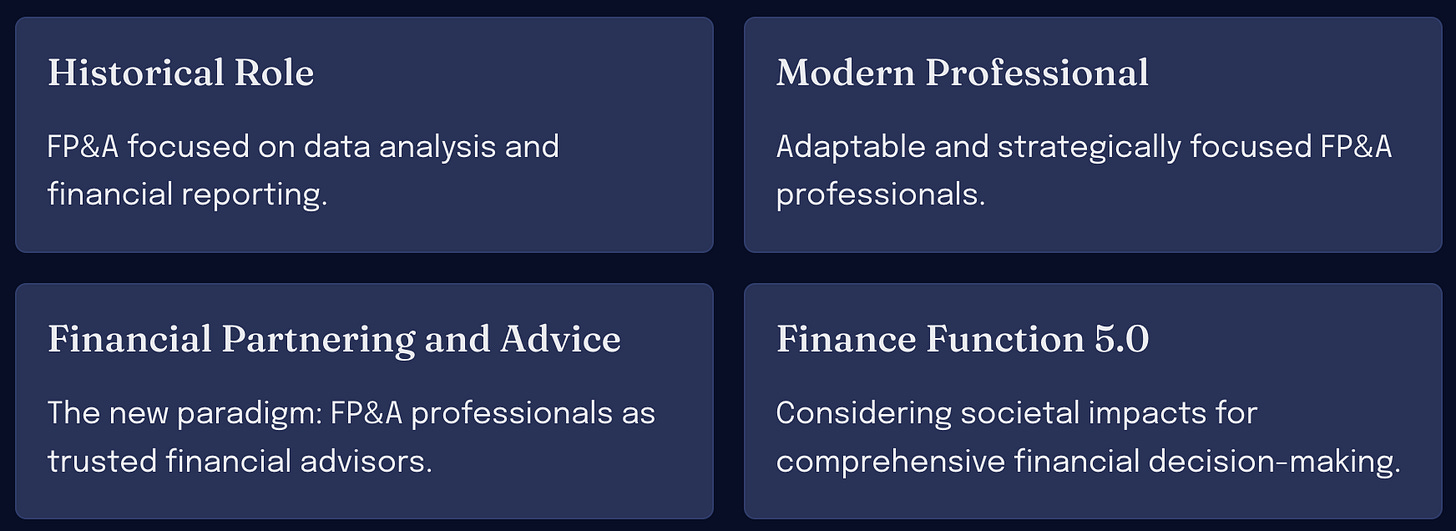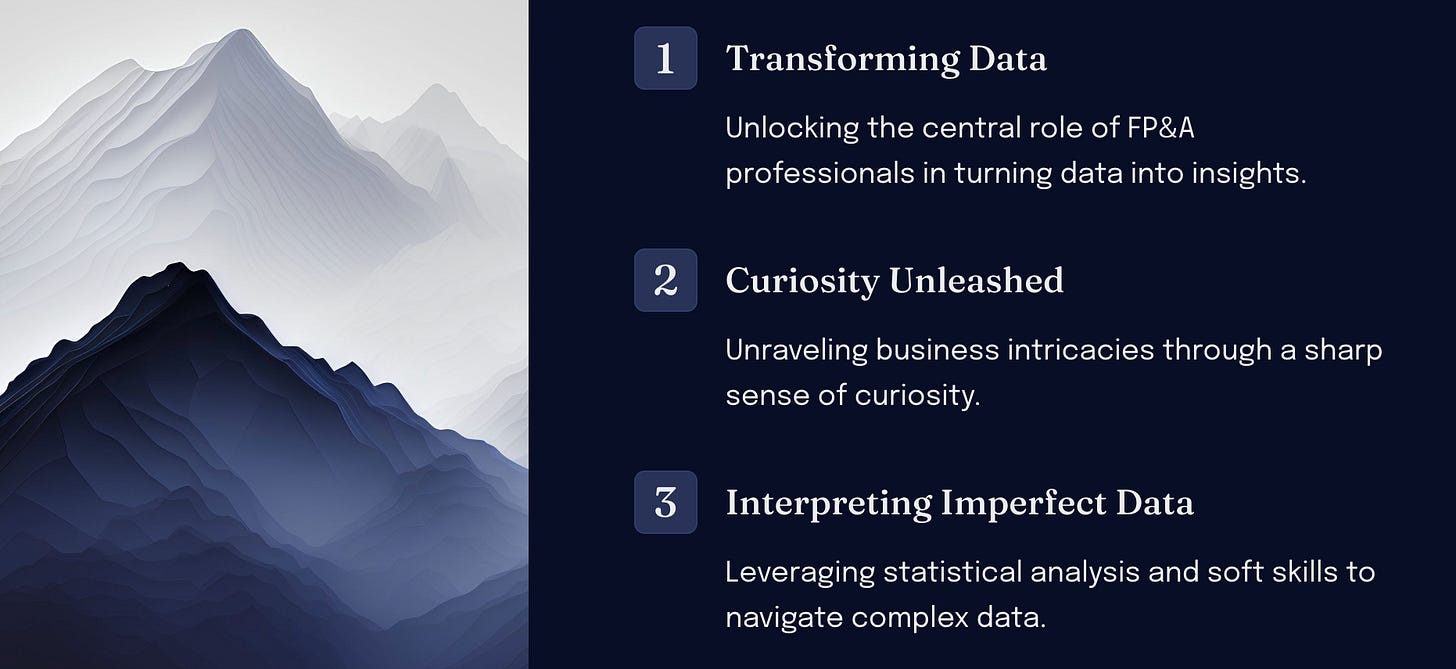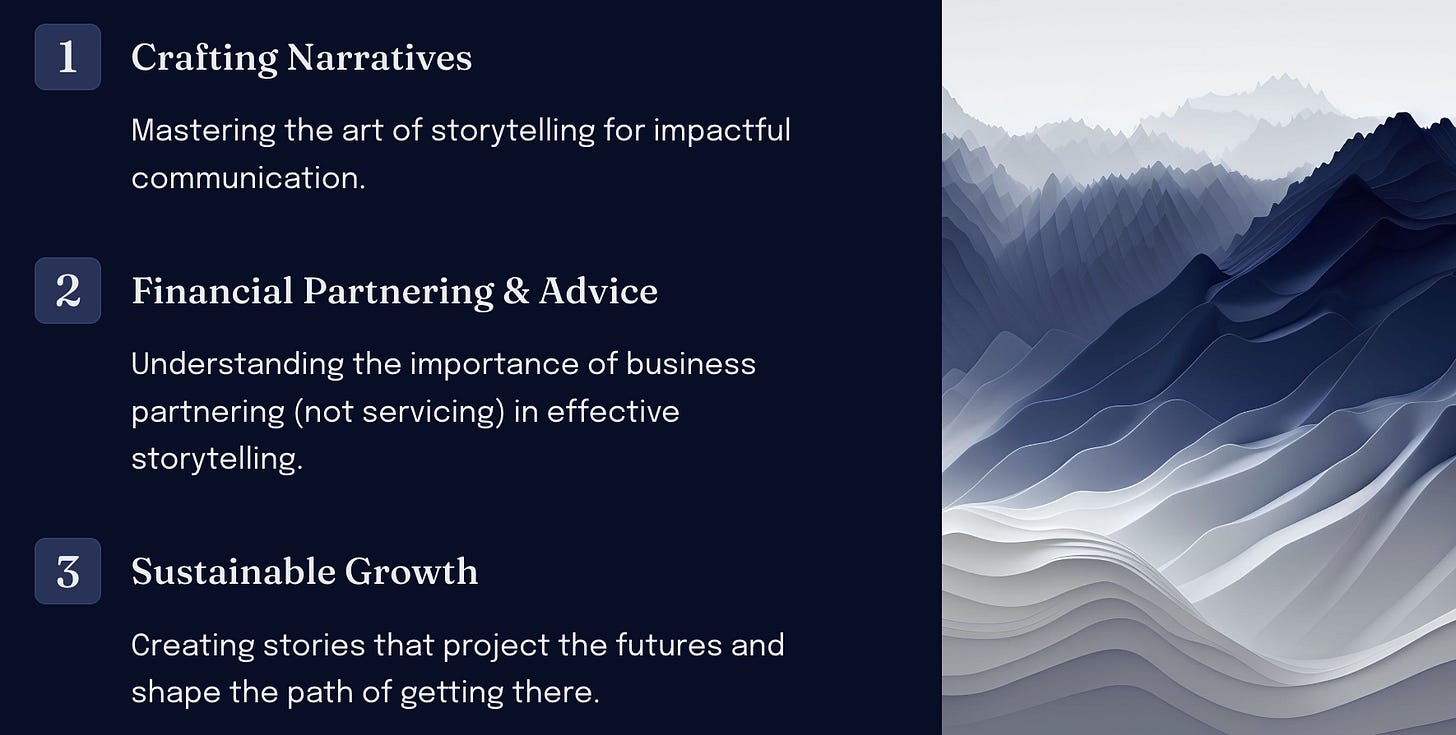Narratives in Numbers: The Critical Role of Soft Skills in FP&A
A balance of hard and soft skills enables us to craft compelling narratives.
Introduction
Finance is in a constant evolution and some call it a transformation. Whatever the terminology, the shifting expectations mean that finance professionals need to move beyond the traditional hard skills of number crunching and data analysis. Today, FP&A professionals are expected to navigate a landscape that demands both technical proficiency as well as a well-honed set of soft skills.
The current blogpost draws heavily on two podcast episodes. The first is Tech for Finance Ep.034 with Gary Cokins [1] and the second an FP&A Today podcast episode Kenneth Fick: FP&A as Influence without Power [2]. Ideas drawn from Chris Ortega, Adam Shilton and others referenced accordingly below.
Skeptics argue that the core of finance revolves around hard data and concrete numbers in order to make sure that all the outcomes are accurate and therefore trustworthy. However, as Kenneth Fick articulates on FP&A Today, the ever-evolving business environment necessitates a symphony of soft skills such as communication, curiosity, and the ability to craft compelling narratives.
The complex, dynamic nature of today’s financial landscape requires professionals to not only analyze data but to draw insightful narratives from them, to ask the right questions, to envisage broader strategies and to communicate these narratives compellingly to a wider audience.
Skeptics adhering to outdated paradigms fail to recognize the transformative potential of integrating soft skills into the FP&A function. They are possibly tethered to the traditional conceptions of 'efficiency' and 'expertise' — terms which were largely synonymous with quantitative skill sets and the ability to navigate complex financial instruments and data sets with agility and precision.
The rise of finance as business partners, the expansive role of finance advice, and the pressing need for financial planning to be responsive to real-time changes and unprecedented crises like the COVID-19 pandemic, war in Ukraine and increasing number of climate related events highlight the inadequacy of a purely numbers-focused approach to the profession and skills requirements.
The FP&A Landscape — Then and Now
Historically, yes, the FP&A function was heavily rooted in data analysis and financial reporting. The role was somewhat static, confined to rigid structures and focused solely on the numbers. However, modern FP&A professionals, as Gary Corkins emphasizes, must cultivate a flexible approach, ready to embrace change and adapt to the chaotic and dynamic business environment.
Chris Ortega builds on this as a guest in this episode of Role Forward podcast [3], illustrating that Financial Partnering and Advice (FPA) has become the new paradigm in the FP&A domain. Collaborative efforts and cross-functional partnerships forge a pathway to strategic, well-rounded financial planning, requiring both hard and soft skills.
According to Anders Liu-Lindberg in "Welcome to Finance Function 5.0” [4], the journey from Finance 1.0 to 5.0 has been a continual expansion of focus; from transactional roles to analytical, strategic, technology-driven ones, and now towards a role that is tasked with considering the societal impact of financial decisions. Continuing the evolution will be based on the synergy of hard and soft skills, combining data-driven insights with compelling narratives that resonate emotionally with a broad spectrum of stakeholders.
Demystifying Soft Skills in FP&A
Financial Planning and Analysis (FP&A) transcends beyond rigid numbers and data metrics. Soft skills are becoming ever more valued to steer business towards strategic goals. Expert voices in the industry, such as Gary Cokins and Kenneth Fick, echo the sentiment that the modern FP&A professionals should be adept at sculpting narratives that provide not just insights but actionable recommendations derived from a deep understanding of the business landscape. Accordingly, soft skills are pivotal in addressing the unforeseen questions, offering detailed explorations and fostering a broader outlook. Without relevant questions and capability to ask them in an open way, FP&A cannot provide the value that business needs.
Furthermore, the art of storytelling is becoming ever more valued with stakeholders accustomed to appealing narratives from everywhere “other than finance”, requiring professionals to harness their communicative (soft skill) capabilities to craft narratives beyond data. FP&A needs to not be afraid or ashamed of imperfections in the data, rather turn these into an advantage based on curiosity rather than stringent “criteria”. Fostering a culture that values listening and learning in forecasting will add more value and relevant timely information for decision making compared to ensuring being strictly right. Hence, the FP&A is about offering more than just numbers but stories that shape and narrate the path to success.
From Data to Actionable Insights
In a world overwhelmed with data, FP&A professionals are tasked with the monumental role of not just presenting data, but transforming it into actionable insights that steer strategic decisions [2]. This transformation is not just a mechanical translation but a deeply investigative process, often requiring a nuanced understanding of both the data and the broader business context.
The cultivation of soft skills, including influence and communication, is crucial to rise to the challenge. It is these skills that enable you to delve beyond surface-level data, fostering a curiosity that seeks to unravel the intricacies of business dynamics and offer grounded, insightful recommendations [2]. Kenneth Fick advocates for an approach that is based on understanding the functioning of the business, which is imperative to be able to transition from raw data to comprehensive, actionable insights.
Going further, it is not only about turning data into insights but also portraying it effectively. Leveraging the insights from Gary Corkins [1] and Chris Ortega [3], we find that FP&A professionals must be skilled at creating narratives from numbers, telling stories that resonate with stakeholders and prompt decisive actions. At the same time, this transition from data to a narrative relies on a profound understanding of statistical analysis — an area that despite discussions around soft skills remains largely untapped as well. Leveraging imperfect data, and being prepared to work with what is available rather than waiting for the perfect dataset, becomes an invaluable strategy in this context, but you need to know how to interpret the “bad” data to not create erroneous insights.
Soft Skills in Action – The Art of Storytelling
The art of storytelling emerges as a vital tool in the FP&A toolkit. It’s about crafting narratives that offer deeper insights and drive home the salient points effectively, thereby transcending the boundaries of mere data representation. This approach calls for a readiness to work with imperfect data and harness one's curiosity to carve out reliable insights through a flexible approach, leaning more towards inquiry than rigid structures [2]. By weaving data into a narrative, FP&A professionals guide stakeholders through complex financial landscapes, emphasizing key points and offering a more comprehensive view of the prevailing business trends. The narrative approach facilitates understanding and aids in making grounded decisions.
Drawing upon insights from Chris Ortega [3], it becomes apparent that crafting narratives isn't solely about presenting data but is significantly about financial partnering and providing substantial advice based on well-articulated insights. This depth of understanding enables financial experts to craft stories that not only illustrate the present scenario but also project potential futures, offering a roadmap for sustainable growth.
Soft Skills in Practical Applications – Leveraging ChatGPT
FP&A professionals have a potent tool at their disposal — Generative AI. Analysts do not need to wonder what it means when they get feedback that they need to use soft skills or what is the algorithm to use to be the business partner that is expected from them. The open ended questions or the inquisitive, but kind, approach to bring out the real needs and expectations of business can be drawn out from the tools we have at our disposal.
One effective framework that I’ve recently come across is SPICES devised by Adam Shilton [5]:
[S] - Scenario
[P] - Profile
[I ] - Information
[C] - Command
[E] - Example
[S] - Structure
Drawing on this, including further examples from Adam’s other materials, I compiled the following prompt template for finance professionals to draw out their soft skills. Sections eluding to utilization of soft skills in bold:
You work as a [specify your role, e.g., financial analyst] in a [specify the company profile, e.g., leading European retail bank]. (Scenario + Profile)
You are tasked with [detail the task, e.g., modeling scenarios for a management meeting concerning a crucial pricing decision] that has a substantial effect on [mention the areas impacted, e.g., the bank's profitability and public perception]. (Information)
Please ensure that the [specify the deliverable, e.g., model] is pertinent to the industry where applicable. Furthermore, craft it with a storytelling approach to facilitate understanding and engagement from non-finance professionals. Emphasize the narrative behind the numbers, showcasing potential paths and solutions, rather than just presenting data. (Information + Command)
Please produce (Command + Structure):
A set of 5 questions to be posed to your business counterparts to expand on their needs and requirements. Focus on getting to the why and value. Be curious and open, encouraging them to share not only what they think they want from you but also insights and narratives that will guide the analysis.
Create 3 potential outlines for the [specify the type of model, e.g., financial] model, each reflecting different degrees of adaptability to changing market conditions.
Develop 3 potential outlines to portray the impacts of the scenarios, envisioning both optimistic and pessimistic outcomes, and emphasizing the narrative behind each scenario.
For each presentation outline, devise a set of 10 slides, where each slide narrates a part of the story, providing to stakeholders the impacts in a visually appealing way.
Each slide should encapsulate 5 bullet points that underline the key discussions or conclusions, fostering a conversation that is grounded in data yet open to insights and interpretations.
Before you carry out this task, please clarify whether you understand the task, and suggest ways this instruction can be altered for you to produce the best possible output.
Conclusion
As we are evolving and transforming towards Finance 5.0 or to Finance Partnering & Advice, a balanced focus on hard and soft skills will enable us to thrive in our roles. The expert insights in this blog post underline a critical role for finance professionals of the future: to be adept storytellers who can craft compelling narratives.
To be slightly poetic, these professionals are not just number crunchers; they are artists weaving stories through a tapestry of data, ready to unearth pathways laden with rich insights. I believe that thriving in the evolving finance profession necessitates a duality of approach. It demands an ability to resonate not merely through numbers but through the rich narratives that embody them, enabling us to create a more nuanced understanding of the business landscape we navigate.
References
[1] G. Cokins, "Moving from Opinion to Facts in Reducing Business Risk," Tech for Finance Podcast Ep.034, August 22, 2023.
[2] K. Fick, "FP&A as Influence without Power," FP&A Today Podcast, June 21, 2022.
[3] C. Ortega, "Financial Transformation in Finance’s Golden Age with Chris Ortega of Fresh FP&A," The Role Forward: A Strategic Finance Podcast, 13 February 2023.
[4] A. Liu-Lindberg, "Welcome to Finance Function 5.0," LinkedIn Pulse
[5] A. Shilton, “SPICES: A 6 Part ChatGPT Framework,” LinkedIn, August 2023.








